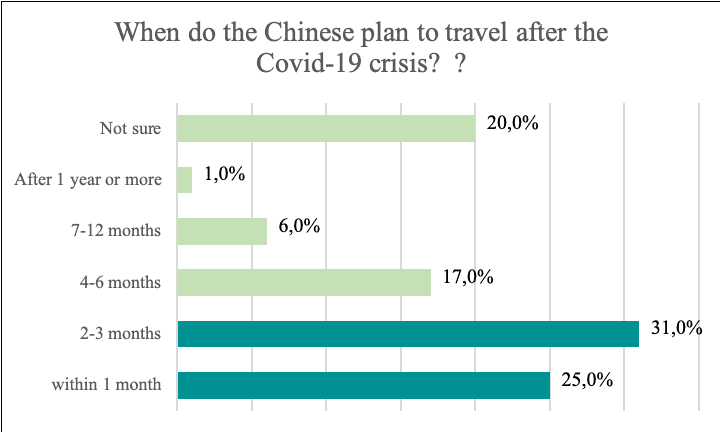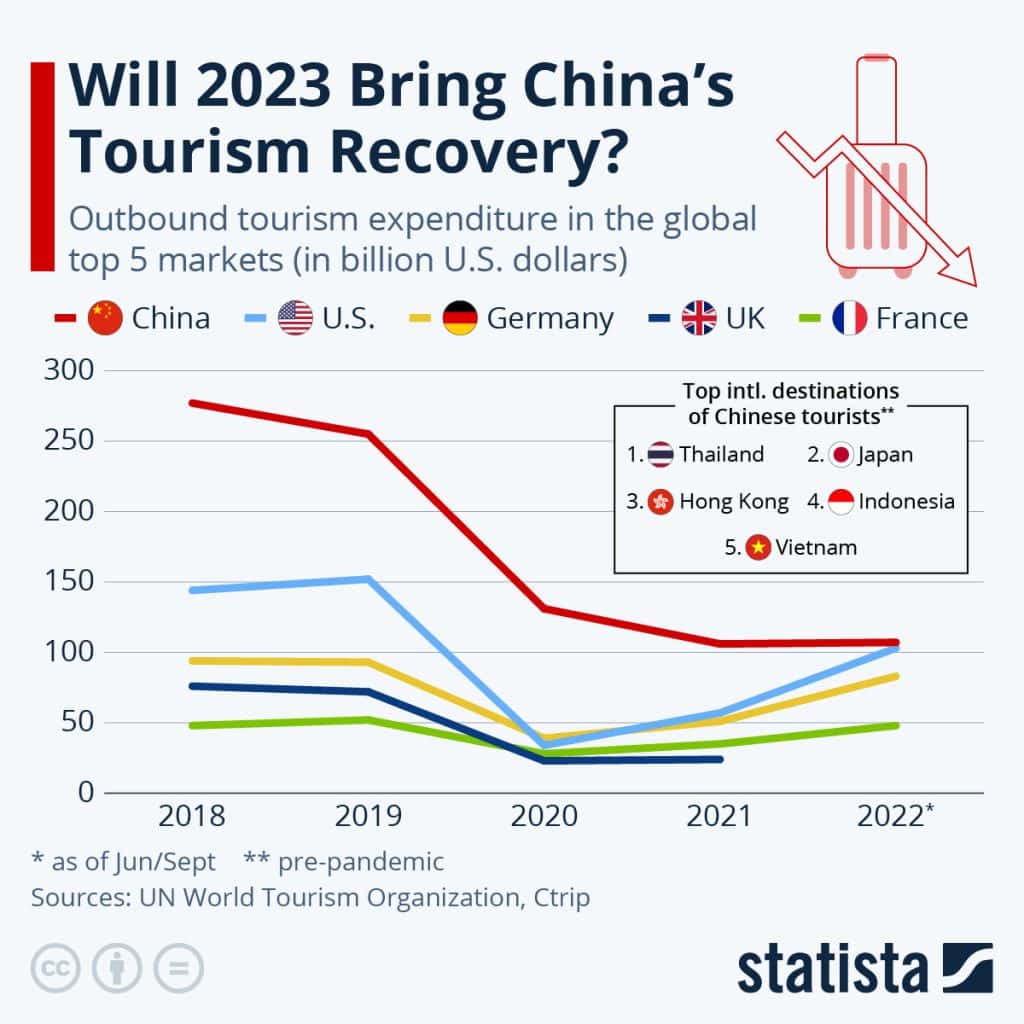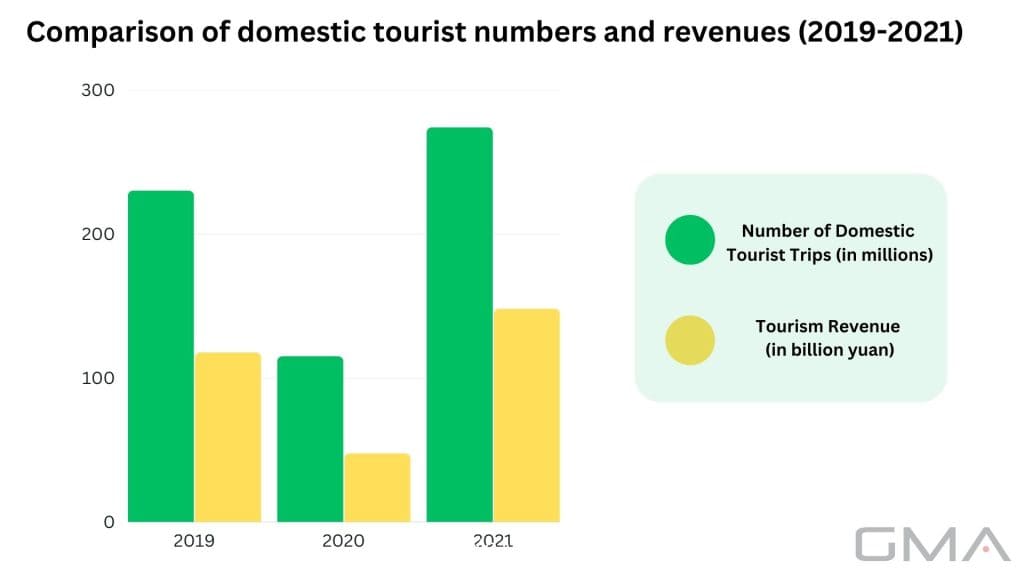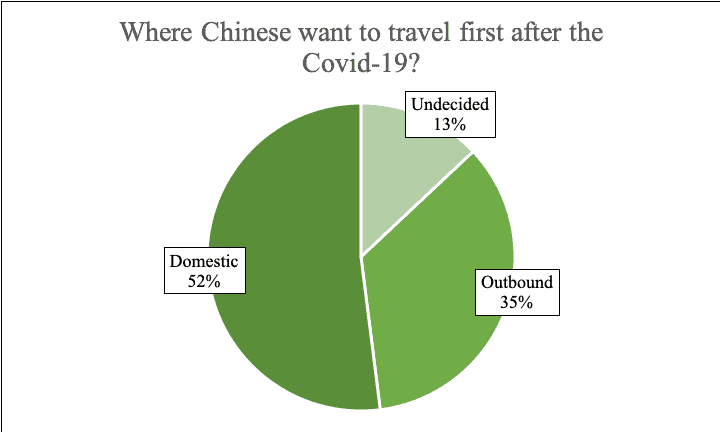China Domestic Tourism Back To Pre-pandemic Levels?
The COVID-19 pandemic led to a significant decline in China’s domestic tourism as people stayed home to prevent the spread of the virus. This had a severe impact on the industry, resulting in lost revenue and job losses.
Before the pandemic, the Chinese travel and tourism sector employed around 28.25 million people directly in 2019. However, lockdowns and restrictions caused a sharp decrease in employment.
Despite the challenges faced by businesses and travelers, recent data shows a notable rebound in domestic tourism. This presents opportunities for a forward-thinking marketing strategy focused on post-COVID era recovery.
As nationwide recovery efforts gain momentum, it’s crucial to consider the potential for growth and engagement in the revived domestic tourism market.
Key Takeaways
- China’s domestic tourism industry has recovered to pre-pandemic levels, with a 19% increase in tourist trips compared to the same period in 2019 and a tourism revenue reaching 148 billion yuan – a 128.9% increase from 2020
- The recovery can be attributed to proactive government initiatives such as travel incentives and discounts, promotion of local attractions, and shifting consumer behavior, with Chinese tourists now showing a preference for off-the-beaten-path destinations and unique experiences post-pandemic.
- Digital technology played an instrumental role in promoting local destinations amidst fierce competition from international alternatives; this includes online platforms used for bookings and social media promotions.
Recovery Efforts from Covid-19
China’s domestic tourism industry has made a remarkable comeback as recovery efforts ramped up in the wake of the pandemic.

One shining example of these recovery efforts is the astounding rebound witnessed during the five-day May Day break in 2023, when domestic tourism numbers rose by more than two-thirds compared to previous years.
This surge in travel not only boosted China’s economy but also reaffirmed vacation demand among its citizens. The quick turnaround can be credited to various stimulus measures introduced by authorities like travel incentives and discounts, alongside the promotion of local attractions aimed at enticing Chinese tourists back into exploring their own country.
Government Policies And Initiatives To Boost Domestic Tourism
Travel Incentives And Discounts
In light of the COVID-19 pandemic, the government has implemented several policies and initiatives to revive the tourism industry, including:
- Offering discounted tickets to popular tourist attractions.
- Providing vouchers or cashback for tourists who book accommodations or travel packages within China.
- Encouraging local governments to promote regional attractions through discounts or promotional campaigns.
- Partnering with online platforms and social media influencers to showcase attractive destinations and attract more visitors.
- Supporting airline companies by offering reduced rates on domestic flights.
These measures, combined with relaxed pandemic-related travel restrictions and targeted pandemic control measures, have fueled a surge in tourism demand during events like the May Day holiday break. So, businesses looking to sell products in China should capitalize on these government policies by tailoring marketing strategies towards domestic tourism opportunities.

Promotion Of Local Attractions
As part of the government’s efforts to boost domestic tourism, there has been a focus on promoting local attractions across China. This includes highlighting lesser-known destinations and encouraging travelers to explore smaller cities and rural areas.
For example, in Yunnan province, a campaign was launched to promote “slow travel” and encourage visitors to experience authentic local culture. This led to an increase in tourists visiting off-the-beaten-path locations such as Nujiang Canyon and Tengchong volcanic hot springs.
By promoting local attractions, China is not only diversifying its tourism offerings but also supporting small businesses that are vital for the country’s economic growth.
China’s Domestic Tourism Bounces Back to Pre-Pandemic Levels
Increase In Domestic Tourism Numbers
According to China’s Ministry of Cultural and Tourism, domestic tourism in China saw a significant increase during the recent five-day May Day holiday break, indicating a return to pre-pandemic levels. The following table shows a comparison of domestic tourist numbers and revenues between 2019, 2020, and 2021.

Keep an eye on the increasing domestic tourism numbers, as this indicates potential opportunities for businesses to tap into the growing market. With China’s Ministry of Cultural and Tourism reporting a 19% increase in tourist trips compared to the same period in 2019, and tourism revenue reaching 148 billion yuan – a 128.9% increase from 2020 – the time is ripe for organizations to make the most of this upward trend in China’s domestic tourism sector.
Popularity Of Outdoor And Rural Destinations
Travelers are seeking out more remote locations to escape urban areas and embrace nature while still adhering to social distancing measures. For example, Hainan Island, known for its beaches and tropical climate, saw an almost 250% increase in hotel bookings during the three-day Labor Day holiday compared to last year.
The trend towards outdoor and rural destinations is not only driven by a desire for safer travel but also reflects a growing interest in eco-tourism and sustainable travel practices.
As more travelers seek authentic experiences that connect them with local culture and communities, businesses that can showcase unique natural or cultural heritage sites will be well-positioned to capture their attention.
Factors Driving The Recovery
- Government policies and initiatives to boost domestic tourism, such as travel incentives and discounts, have encouraged people to travel within the country.
- The promotion of local attractions by the government and private businesses has enticed tourists to explore new destinations.
- The popularity of outdoor and rural destinations, as people seek to avoid crowded areas and prioritize health safety.
- Increase in the disposable income of Chinese citizens, which allows them to spend more on leisure activities like travel.
- The use of digital platforms for bookings has made it easier for people to plan their trips and reduce physical interaction during booking procedures.

The Role Of Digital Technology In The Recovery
Use Of Digital Platforms For Bookings
Online travel bookings are increasingly becoming the norm as the pandemic continues to disrupt traditional travel methods. Chinese consumers have embraced digital platforms for booking tickets and other travel-related services since they value convenience, flexibility, and social distancing.
To tap into this growing trend effectively, businesses must recognize that Chinese tourists’ preferences have changed significantly in recent times. Shorter domestic trips and outdoor activities remain popular among travelers who prioritize fresh air and natural surroundings over crowded urban areas or indoor venues.
Impact Of Social Media On Promoting Destinations
The use of social media platforms like WeChat and Weibo has been instrumental in driving demand for local attractions as they provide an opportunity for businesses to communicate with their target audience directly.
In addition, influencers have played a significant role in promoting domestic tourism by sharing their experiences on various digital channels. Influencers encourage travelers to visit different places while providing valuable insights into what visitors can expect from such trips.
Lastly, social media advertising strategies targeted at consumers who are most likely interested in traveling also play a crucial role in attracting travelers. WeChat ads targeting individuals who search for specific keywords or demographics can help reach these audiences effectively.

Predictions For Sustained Growth In Domestic Tourism
Based on current trends and data, it seems that there will be sustained growth in this sector for years to come. The China Tourism Academy predicts that domestic tourist trips will increase by 73% this year alone, reaching 4.55 billion.
Opportunities and Challenges
We believe it’s important to consider both the challenges and opportunities presented by China’s domestic tourism industry. Here are some challenging points to keep in mind:
- Travel restrictions: While China has been rapidly lifting travel restrictions, the situation could change at any time due to COVID-19 outbreaks. This creates uncertainty for businesses in the tourism sector.
- Competition: With many businesses eager to tap into the growing domestic tourism market, competition for consumer attention and spending will be fierce.
- Changing consumer behavior: As Chinese tourists increasingly seek out new experiences and unique destinations in smaller cities, businesses will need to adapt their offerings accordingly.
- Regional differences: Different regions of China have varying levels of economic growth and varying levels of interest among tourists. Understanding these differences will be key to targeting the right audience.
On the other hand, there are also numerous opportunities for businesses looking to sell products in China’s domestic tourism market:
- Rapid growth: The China Tourism Academy predicts a massive increase in domestic tourist trips this year, offering huge potential for revenue growth.
- Government support: The Chinese government has implemented policies and initiatives aimed at boosting domestic tourism, giving businesses additional support.
- Digital transformation: The use of digital platforms for booking travel arrangements is becoming increasingly popular among Chinese consumers, presenting an opportunity for tech-savvy businesses.
- Social media promotion: Social media plays a huge role in promoting destinations among younger Chinese travelers, offering additional opportunities for social media-savvy businesses.
Implications For Businesses Looking To Sell Products In China
Understanding The Changing Consumer Behavior
The pandemic caused a significant shift in travel behaviors and intentions during the crisis, leading to changes in retail habits and confidence levels.

One way businesses can tap into this market is through market segmentation. By identifying customer segments that are most likely to engage with their products or services, companies can tailor their marketing efforts specifically to those groups’ needs and preferences.
Strategies For Tapping Into The Tourism Market
With travel demand returning to pre-pandemic levels, it presents a significant revenue opportunity for businesses. Here are some strategies for tapping into the Chinese tourism market:
- Target popular destinations within China and tailor your marketing collaterals towards them.
- Use social media platforms like WeChat, Weibo, and Douyin to reach Chinese tourists.
- Offer affordable and attractive travel packages that cater to different demographics.
- Leverage partnerships with local tour operators or hotels to offer bundled services that appeal to tourists.
- Provide personalized experiences that cater to individual preferences, such as cultural activities or outdoor adventures.
- Understand changing consumer behaviors in the Chinese tourism industry and adapt your product offerings accordingly.
- Utilize technology platforms to streamline the booking process for travelers.
- Provide that all communication is available in Mandarin or other commonly spoken languages in China.
Case Studies Of Successful Businesses In The Tourism Sector
Ctrip, China’s largest online travel agency, has launched several initiatives to help drive domestic tourism recovery, such as providing discounts for hotel stays and implementing health and safety protocols at hotels.
Another case study is Sunac Cultural Tourism Group, which has shifted its focus to developing outdoor destinations and rural tourism experiences. This strategy aligns with the current trend of Chinese tourists seeking out nature-centric experiences post-pandemic.
These examples demonstrate how businesses can pivot their strategies quickly in response to changing consumer behavior due to COVID-19 while also tapping into new opportunities that may arise in the industry.

China’s Domestic Tourism Soars to Pre-Pandemic Levels: We’re Here to Help You Capture the Opportunity
As China’s domestic tourism rebounds to pre-pandemic levels, businesses are increasingly eager to tap into this thriving and lucrative market. Understanding the evolving consumer behavior and developing effective marketing strategies have become essential for attracting tourists. With our extensive experience in the industry, we are more than willing to assist you in navigating this exciting landscape.
At a time when travel restrictions are easing and wanderlust is on the rise, the resurgence of domestic tourism in China presents a remarkable opportunity for businesses across various sectors. However, it is crucial to recognize that consumer preferences and expectations have evolved in response to the pandemic. To succeed in this highly competitive environment, it is essential to comprehend the shifting trends and tailor your offerings accordingly.
Here at GMA, we have a deep understanding of the Chinese tourism market and a proven track record of assisting businesses in maximizing their potential. Our expertise spans a range of areas, including market research, consumer behavior analysis, and developing tailored marketing strategies. By leveraging our knowledge and insights, you can position your brand effectively, cater to changing preferences, and capture the attention of eager tourists.

As travelers seek unique experiences, immersive cultural encounters, and enhanced safety measures, it is imperative to align your business with these evolving demands. Our team of professionals is dedicated to staying up-to-date with the latest trends and can provide invaluable guidance on how to adapt your offerings to attract Chinese tourists. From personalized travel itineraries to innovative marketing campaigns, we are well-equipped to help you create memorable experiences that resonate with this diverse and discerning audience.
If you are looking to tap into the potential of China’s resurging domestic tourism market and need assistance in understanding the ever-changing consumer landscape or developing effective marketing strategies, we are here to lend a helping hand. Contact us today, and let us guide you toward success in this exciting and dynamic industry.







